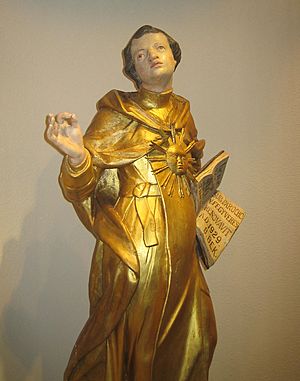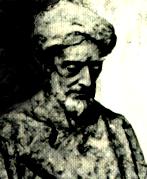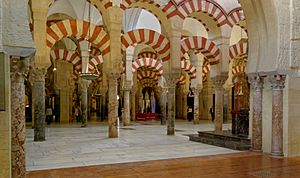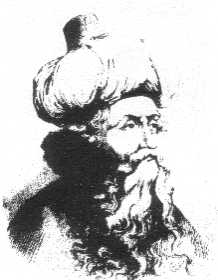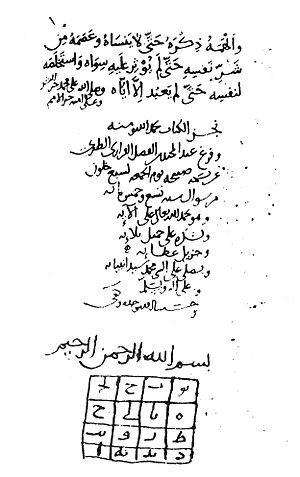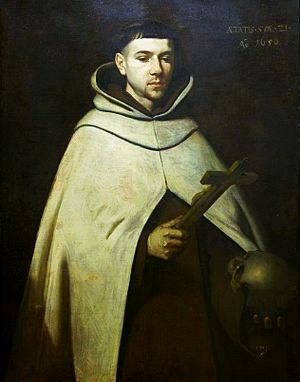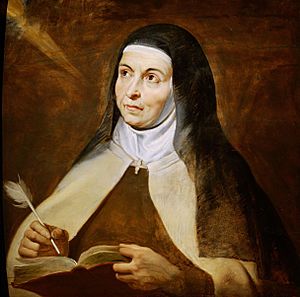Miguel Asín Palacios facts for kids
Quick facts for kids
The Most Excellent
Miguel Asín Palacios
|
|
|---|---|
| Born | 5 July 1871 Zaragoza, Spain
|
| Died | 12 August 1944 (aged 73) San Sebastián, Spain
|
| Seat d of the Real Academia Española | |
| In office 26 January 1919 – 12 August 1944 |
|
| Preceded by | Enrique Ramírez de Saavedra |
| Succeeded by | Dámaso Alonso |
| Director of the Real Academia Española | |
| In office 23 June 1943 – 12 August 1944 |
|
| Preceded by | Francisco Rodríguez Marín |
| Succeeded by | José María Pemán |
Miguel Asín Palacios (born July 5, 1871 – died August 12, 1944) was a Spanish expert in Islamic studies and the Arabic language. He was also a Roman Catholic priest. He is famous for suggesting that some ideas in Dante's famous poem, Divine Comedy, might have come from Muslim writings. He wrote about this in his book La Escatología musulmana en la Divina Comedia (1919).
Asín Palacios also studied medieval Islam, especially the works of al-Ghazali and Muhyiddin ibn 'Arabi. He wrote about how Islamic ideas might have influenced Christianity and mysticism in Spain.
Contents
About His Life
Miguel Asín Palacios was born in Zaragoza, Aragón, Spain, on July 5, 1871. His family was not rich, but they managed well. When he was young, his father passed away. He had an older brother, Luis, and a younger sister, Dolores.
He went to a school run by Jesuits in Zaragoza, where he made friends for life. He later studied to become a priest and held his first Mass in Zaragoza in 1895.
At the University of Zaragoza, Asín met Professor Julián Ribera y Tarragó, who was an expert in Arabic studies. Ribera became his teacher and mentor. In 1896, Asín presented his important paper on the Persian thinker Ghazali in Madrid. Other famous professors, Francisco Codera Zaidín and Marcelino Menéndez y Pelayo, guided his studies. Asín later published his work on Al-Ghazali in 1901. He also wrote about Mohidin Abenarabe, a leading figure in Islamic mysticism. This showed his interest in understanding Muslim spiritual ideas.
In 1903, Professor Codera retired from his teaching position at the University of Madrid so Asín could take his place. Asín moved to Madrid and was well-received at the university. By 1905, Professor Ribera also moved to Madrid, and together they started a journal called Cultura Española. Asín attended international meetings in Algeria (1905) and Copenhagen (1908), where he met other experts in Islamic studies. He became very successful in Madrid and even became friends with King Alfonso XIII. In 1921, he was chosen as a foreign member of the Royal Netherlands Academy of Arts and Sciences.
Asín Palacios was known for his academic work on how medieval Muslim and Christian ideas, beliefs, and practices connected, especially in Spain. He studied important thinkers like Al-Ghazali, Ibn 'Arabi, Averroës, and Maimonides. He also compared Islamic ideas with those of Christian thinkers like Ramon Lull, Thomas Aquinas, Dante Alighieri, Teresa of Avila, and John of the Cross.
He had a special way of working: he would plan his writing very carefully, outlining everything in detail. Then, he would write it all down without needing a rough draft, adding all his research notes as he went.
In 1932, Asín Palacios started directing a new academic journal called Al-Andalus, which was for experts in Arabic studies. He often wrote articles for it himself. A new generation of Spanish Arabists, like Emilio García Gómez, were inspired by his work. In 1936, he was made an honorary member of the American Academy of Arts and Sciences.
The Spanish Civil War started in July 1936. Asín Palacios was visiting his family in San Sebastián when it began. The war was very difficult for everyone, and many priests were in danger. Luckily, nationalist forces took control of San Sebastián that September. During the war, he taught Latin and managed to get copies of Arabic texts to continue his studies. After the war, Asín returned to Madrid and continued teaching at the university. He also kept working on his large study of Al-Ghazali.
People described Miguel Asín Palacios as having intense black eyes and fine hands. He was always well-dressed. He wasn't interested in being famous, only in having peace and quiet to do his work. He was a kind and generous friend. His colleagues saw him as innocent and pure-hearted. He was a very religious priest and died on August 12, 1944, in San Sebastián. Many scholars reviewed his work after his death.
His Important Works
After his early writings on Al-Ghazali and Ibn 'Arabi, Asín Palacios worked on many other Arabic texts. He translated them into Spanish and wrote books and essays about related topics. Sometimes, he even wrote in Latin, French, or Italian.
Aquinas and Averroës
Asín Palacios studied how Muslim ideas might have influenced Tomás d'Aquino (around 1225-1274), a famous Christian philosopher. He thought these influences likely came from Ibn Rushd of Córdoba (1126–1198), known as Averroës in Latin. Asín wrote an article about this in 1904.
He believed that Averroës and Aquinas, as well as the Jewish philosopher Maimonides, all used reason to understand their faith. Asín tried to show that Averroës used reason in a religious way, unlike some other thinkers who were less religious. Many Christian scholars at the time disagreed with Asín's ideas.
Ibn Masarra
In his 1914 book, Abenmasarra y su escuela, Asín described how Islamic philosophy developed in the East and then in Al-Andalus (Muslim Spain). He wrote a short biography of Ibn Masarra (883-931). Asín believed that Ibn Masarra was a Muslim 'Spaniard' whose family had converted to Islam. He also thought Ibn Masarra was influenced by Greek philosophy, especially neoplatonism.
Ibn Masarra faced accusations of heresy and had to hide his teachings. He traveled to Mecca but later returned to Córdoba under a more tolerant ruler. There, he started a school that included elements of Sufism.
Asín's book also looked at the general ideas of early Muslim mystics in al-Andalus. He discussed how Ibn Masarra's school influenced later figures like Ibn al-Arif and Jewish thinkers like Solomon ibn Gabirol. Asín believed that these Muslim and Jewish thinkers from Spain had a big impact on medieval Christian theology. His research showed how Ibn Masarra's ideas continued to influence thinkers like Ibn 'Arabi, Ramon Lull, and Roger Bacon.
Dante Alighieri
Asín Palacios is perhaps best known for his 1919 book, La Escatologia Musulmana en la Divina Comedia. This book caused a lot of discussion among experts on Dante. In it, Asín suggested that the Italian poet Dante Alighieri (1265–1321) might have used Muslim religious stories as inspiration for his famous poem, La Divina Commedia.
Specifically, Asín compared the Muslim stories of Muhammad's night journey (where he traveled from Mecca to Jerusalem and then up through the seven heavens) with Dante's story of his spiritual journey through the afterlife.
Before Asín's book, people thought Dante was mainly inspired by the ancient Roman poem Aeneid. Asín argued that adding Muslim sources didn't make Dante's work any less amazing. He believed Dante's poem remained a masterpiece.
Asín's book led to much debate and more research. Later, two scholars found an old Arabic book from the 11th century called Kitab al-Mi'raj (Book of the Ladder). This book described Muhammad's night journey and was translated into Spanish in 1264. It was also translated into Latin, and this Latin version might have been known to Dante's teacher, Brunetto Latini. Even though Asín didn't have this exact link, he based his work on similar Muslim stories that were common in Al-Andalus.
Ibn Hazm
Asín recognized the importance of Ibn Hazm of Córdoba (994–1064) to Muslim culture in Spain. Ibn Hazm was a remarkable figure who wrote about theology, law, and poetry.
From 1927 to 1932, Asín published a five-volume study called Abenházam de Córdoba y su historia crítica de las ideas religiosas. The first volume was a biography of Ibn Hazm. The other four volumes were a long translation of Ibn Hazm's work Fisal, which was about the history of religious ideas.
In his Fisal, Ibn Hazm described different religions, including Christianity and Judaism. Asín noted that Ibn Hazm was one of the first historians of religions. Asín also pointed out that Ibn Hazm, as a legal scholar, discussed when it might be acceptable to rebel against an unfair ruler.
Ibn 'Arabi
Another important work by Asín focused on the life and philosophy of Muhyiddin Ibn 'Arabi (1165–1240) from Murcia, Spain. Asín had already written several studies on this respected (and sometimes debated) mystic. His main work was El Islam cristianizado. Estudio del sufismo a través de las obras de Abenarabi de Murcia (1931).
In this book, Asín suggested that Sufism (Islamic mysticism) might have been influenced by Christian monasticism. The book had three parts: a biography of Ibn 'Arabi, a discussion of his complex writings and mystical teachings, and translations from his works.
Asín's biography described Ibn 'Arabi's spiritual journey, his meeting with Averroës, and his travels across North Africa and the Middle East. Ibn 'Arabi wrote many books. Asín was one of the first Western scholars to study him. Asín, being a Christian scholar, saw many similarities between Ibn 'Arabi's ideas and Christian mysticism.
One scholar, Professor Alexander Knysh, noted that Asín was interested in finding connections between Christian and Islamic beliefs to encourage dialogue. However, he also pointed out that Ibn 'Arabi himself didn't show much direct influence from Christianity in his writings.
Asín's book also explained the Sufi spiritual journey and its practices. For example, he mentioned Ibn 'Arabi's idea of "four deaths" (dying to hunger, passion, suffering, and worldly things) as a way to prepare for a spiritual transformation. Asín's work showed how deep and complex Ibn 'Arabi's teachings were.
Other Studies
Asín Palacios wrote many other articles on various subjects:
- Blaise Pascal: He compared Pascal's ideas about betting on life after death with similar thoughts by Al-Ghazali.
- Alumbrados: He looked at these Spanish religious groups from the 16th and 17th centuries and found similarities with the Sadili school of Islam.
- Ramon Lull: Asín discussed this mystic who wanted to convert Muslims to Christianity, linking his ideas to Ibn Masarra and Ibn 'Arabi.
- Ibn al-Arif: He studied this 12th-century mystic from Almería, who was influenced by Ibn Masarra.
- Ibn Bajjah: He wrote about this philosopher from Zaragoza, known as Avempace, and his impact on European and Arab philosophy.
Asín always focused on how the different civilizations of Islam and Christianity influenced each other in Spain, both during and after Muslim rule.
Al-Ghazali
In the 1930s, Asín started another study of Al-Ghazali (1058–1111), called La espiritualidad de Algazal y su sentido cristiano. Asín said this work was specifically about a Christian understanding of Al-Ghazali. He focused on spiritual practices from Al-Ghazali's huge work, Ihya 'Ulum ad-Din (Revival of the Religious Sciences).
A British scholar, A. J. Arberry, called Asín's study "the most important monograph on Ghazali so far written" in 1942. However, he also noted that Asín brought Christian ideas into his work on the Muslim theologian. But Asín believed it was fair to do so, given how much the two faiths had influenced each other.
Asín's study of Al-Ghazali's Ihya had four parts:
- First, how to overcome bad habits like anger, greed, and pride.
- Second, the path to unity with God, including ideas like patience, gratitude, and love of God.
- Third, how to achieve spiritual perfection, through things like meditation and religious song.
- Fourth, Al-Ghazali's mystical ideas, which Asín also interpreted from a Christian viewpoint.
John of the Cross
In 1933, Asín published an article about San Juan de la Cruz (1542–1591) and a spiritual idea he shared with Islamic mystics. This article also looked at a Muslim mystic from Ronda, Ibn Abbad al-Rundi (1332–1389), who was a possible influence on John of the Cross.
The shared idea is about the soul's journey towards connecting with God. Since God is beyond human understanding, the soul must give up everything except God. This can lead to a feeling of emptiness or "dark night," but then God might grant inspiration, followed by a feeling of joy. The idea is that by letting go of these ups and downs, the soul can move faster towards a deep connection with God. Asín analyzed the specific words used by both the Sadili mystics and San Juan de la Cruz to show this connection.
While scholars agreed on the similarities, some, like José Nieto, questioned if there was a direct link between the Sadili Sufis and San Juan de la Cruz. They suggested that such similar spiritual experiences could happen naturally to different people.
Teresa of Ávila
In an article published after his death, Asín discussed Santa Teresa de Ávila (1515–1582). He found that the comparisons and stories she used to describe her spiritual experiences were similar to those used by Islamic mystics. For example, she used the image of seven dwelling places or castles, one inside the other, to explain the soul's journey.
Asín mentioned similar ideas in Islamic texts, like the Nawadir, which also described seven concentric castles. He noted other shared symbols, such as God being in the central dwelling.
Later, scholar Luce López-Baralt explored this connection further, tracing the castle image back to a 9th-century Islamic mystic in Baghdad. She suggested that Santa Teresa might have heard about this image indirectly, and it later came to her mind to help her explain her own mystical experiences. Other studies have looked at Saint Teresa's Jewish background and how her mysticism reflected shared values among Jewish, Christian, and Islamic faiths during the time of convivencia (peaceful coexistence) in medieval Spain.
His Impact
Miguel Asín Palacios's works are widely admired, even though some criticized him for being a Christian priest studying Islam. In Spain, his work greatly helped change how many Spaniards viewed the Muslim period of their history, making it seem more positive. His deep understanding of Islamic mysticism brought light to previously unknown figures and connections. Along with other scholars, Professor Miguel Asín Palacios helped the Catholic Church recognize Islam as part of the Abrahamic legacy, which was later mentioned in the Nostra aetate document of Vatican II (1962–1965).
Images for kids
See also
 In Spanish: Miguel Asín Palacios para niños
In Spanish: Miguel Asín Palacios para niños
- The Divine Comedy
- Ibn 'Arabi
- Al-Ghazali
- Ibn Hazm
- Emilio García Gómez
- Luce López-Baralt
- James T. Monroe



